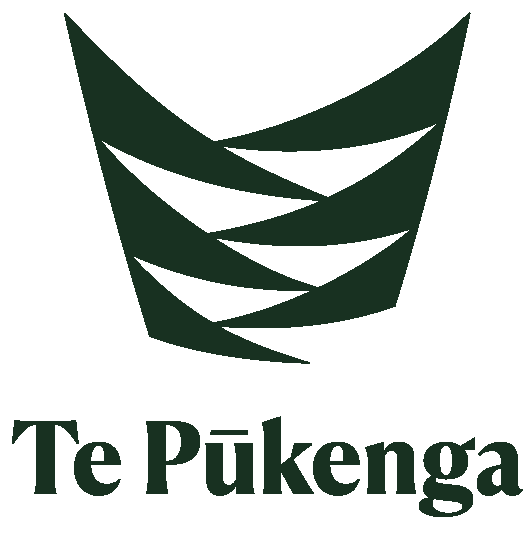

Level 2, Wintec House
Cnr Anglesea and Nisbet St.
Hamilton 3204
0800 86 22 84
info@tepūkenga.ac.nz
tepūkenga.ac.nz
21 November 2024
Jay Rogers
By email: [FYI request #28909 email]
Tēnā koe Jay
Request under the Official Information Act 1982
Thank you for your email of 25 October 2024, requesting the fol owing information from Te Pūkenga
– New Zealand Institute of Skills and Technology (Te Pūkenga):
In a previous OIA in 2023 you released Te Pūkenga Writing Style Guide. In this Writing
Style Guide on page 7- it refers to a seperate [sic] style guide called "Te Pūkenga te
reo Māori style guide"
Can I please request a copy of "Te Pūkenga te reo Māori style guide" please.
The decision
Please find attached Te Pūkenga te reo Māori style guide. Information has been withheld under
section 9(2)(a) of the OIA – protect the privacy of natural persons – on pages 8 and 16.
You have the right to make a complaint to the Ombudsman under section 28(3) of the OIA if you are
not happy with this response. Information about how to do this is available at
www.ombudsman.parliament.nz or by cal ing 0800 802 602.
We may publish our OIA responses and the information contained in our reply to you on our website.
Before publishing we will remove any personal or identifiable information.
Ngā mihi
Gus Gilmore
Tumuaki | Chief Executive
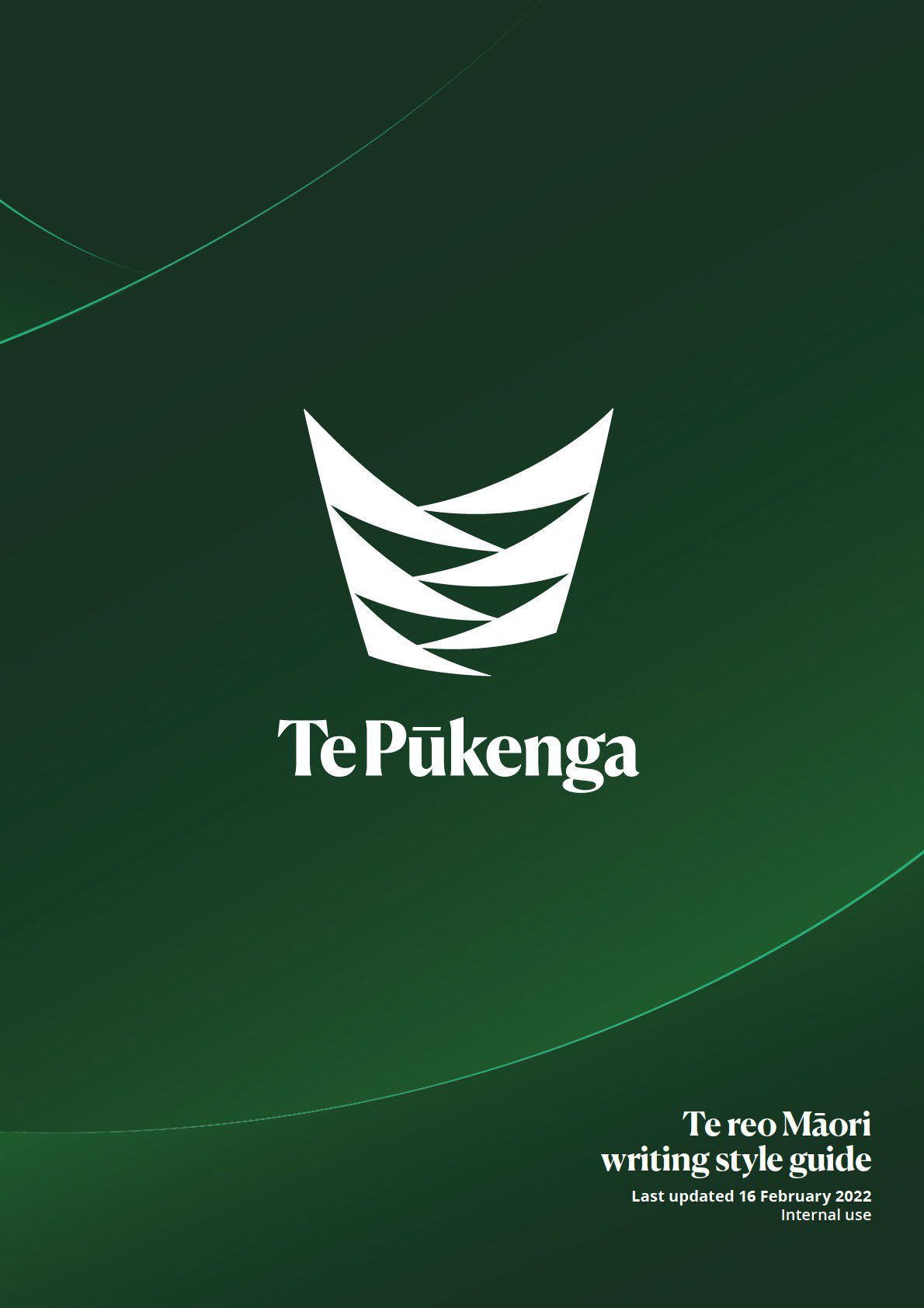
ACT 1982
INFORMATION
RELEASED UNDER THE
OFFICIAL

the 1982
Act
under
Released
Information
Official
Contents
Rārangi Upoko | Contents
Kupu Whakataki | Introduction
4
Te whakamahi i te tohu wehe |
15
Tohutō | Macron
5
When to use the pipe
Te whakamahi i ’te’ me ’ngā’ |
16
Windows 10
5
When ‘to’ and when ‘not to’
MacOS
7
use ‘te’ and ‘ngā’
Te Pūkenga Ohu Reo requests
8
Ngā Ingoa | Proper names
17
Te Pūkenga commonly used translations
8
Capitalisation in proper names
17
the 1982
Mita | Dialect
8
Names of iwi, hapū and other kin groups
18
Oropuare Rua — Tāpara me te
Names of organisations, institutions,
18
Poto |Vowels — Long and short
9
government entities
Oropuare roa | Long vowels
9
Names that begin with ‘O’
18
Act
Exceptions
9
Names of the days and months in
19
Wetewetenga kupu |
Te reo Māori
under
Word division
10
Tikanga ā-tuhi mō ā Te Pūkenga 20
Whaka-
10
tuhinga matua, ingoa, tohu hoki |
Te Pūkenga key documents,
Agentive kai-
10
naming conventions and signage
Compound words
10
Headers
20
Flora and fauna
11
Copy and script writing
20
Words prefixed with ā-
11
Naming and signage
20
Pūmatuatanga | Capitalisation
12
Tāpiritanga | Appendix
21
Pūmau | Possessives
13
Appendix 1 — List of Greetings and
21
Released
Information
Kukutinga | Contractions
13
sign-offs
Te whakamahi kupu Māori i te
14
Appendix 2 —Sample list of Māori words
22
tuhinga reo Pākehā | Explaining
that do not need defining
Māori words in English text
Official
Te Pūkenga Te Reo Māori writing style guide 3
Kupu Whakataki | Introduction
Kupu Whakataki | Introduction
At Te Pūkenga we typical y fol ow Te Taura Whiri i Te reo Māori Guidelines for Māori Orthography:
Ngā Tikanga Tuhi a Te Taura Whiri i Te reo Māori. These are kept updated and can be found as a
downloadable PDF file on Te Taura Whiri i Te reo Māori | Māori Language Commission website,
tetaurawhiri.govt.nz/assets/Uploads/Corporate-docs/Orthographic-conventions/58e52e80e9/
Guidelines-for-Maori-Language-Orthography.pdf
Othography is the written system selected for any language, it includes spel ing conventions, use of
diacritics (the tohutō or macron for Te reo Māori to indicate vowel length), and features of punctuation
such as use of capital letters and hyphenation. We’ve also developed some additional features for the
Te Pūkenga written style.
the
The orthographic conventions for Te reo Māori have changed over time as written use of the language
1982
has developed. What we outline below may be different to what you have seen in other contexts,
and in particular in older printed texts. Depending on the tribal dialect of your region, this may be in
the use of macrons Te reo Māori is the indigenous language of Aotearoa New Zealand and, like New
Zealand Sign Language, is an official language here in Aotearoa New Zealand. Te reo Māori was the
first language to be spoken by the first peoples of the land and we honour Te reo Māori by adopting
the orthographic convention that begins with Te reo Māori, fol owed by the English equivalent. This
Act
is both a reflection of Aotearoa New Zealand’s national and governmental commitment to support
Māori language revitalisation strategies and also to adopt a convention which enables our institution
to use Te reo Māori within English text
under
Te Pūkenga will leverage indigenous col ective impact frameworks already developed for the Aotearoa
New Zealand context and are therefore committed to the preservation and normalisation of Te
reo Māori. Recognising Te reo Māori as one of two official languages by including it throughout our
texts is part of that commitment. Te Pūkenga is also committed to naming and signage where the
orthographic convention begins with Te reo Māori, fol owed by the concept equivalent in English.
Released
Information
Official
4 Te Pūkenga Te Reo Māori writing style guide
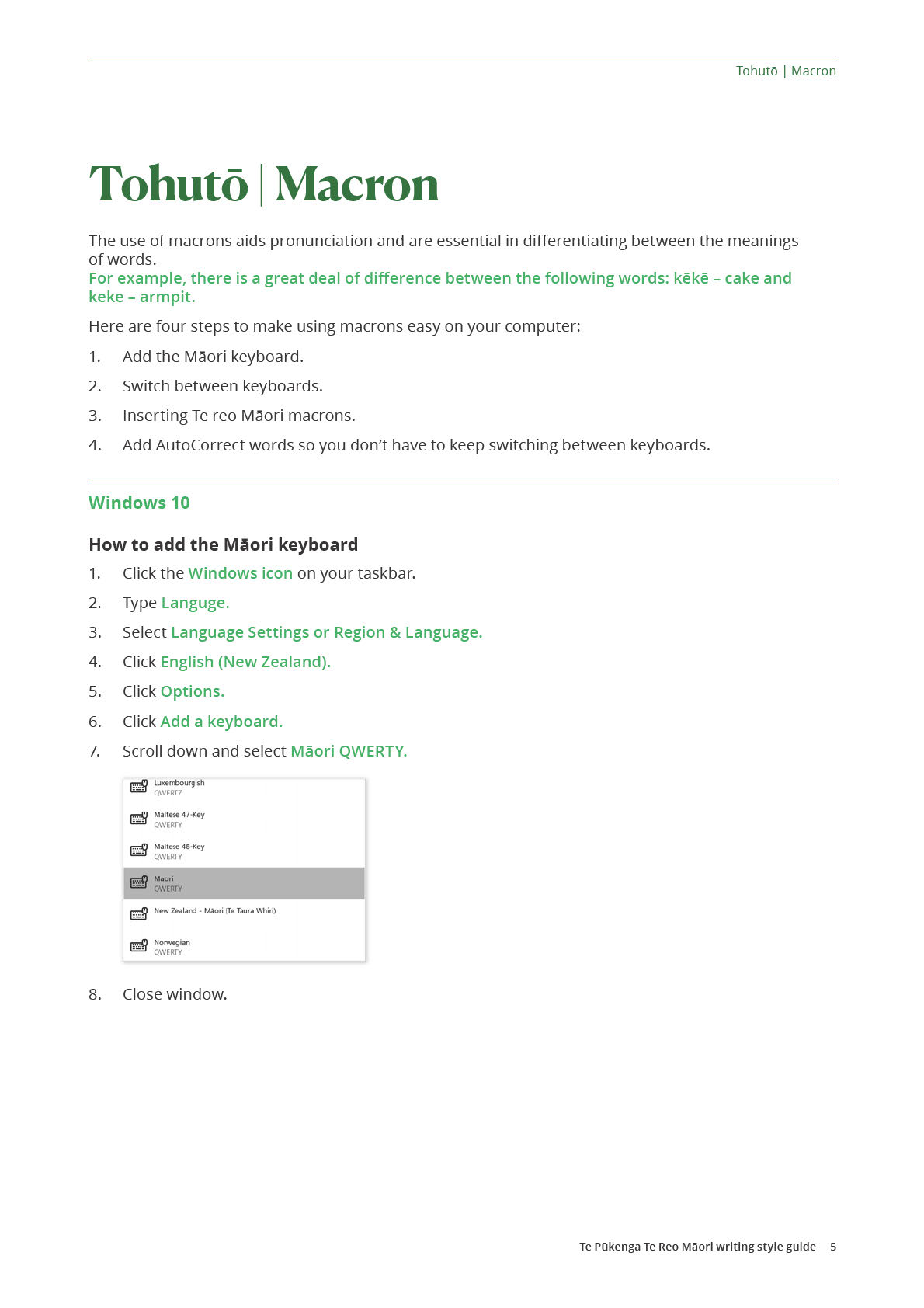
the 1982
Act
under
Released
Information
Official
Tohutō | Macron
How to switch between keyboards
1. Hold down
Windows key and press
Spacebar.
OR
Click
ENG in the bottom right of the task bar.
2. Select the
keyboard you are wanting to use.
How to insert macrons
1. Press the
tilde ~ symbol key on your keyboard and then the vowel to create the macron.
the 1982
For uppercase, press
tilde, then
shift, then the vowel.
How to add AutoCorrect words so you don’t have to keep switching between keyboards
1. Check that your
Māori keyboard is selected.
Act
2. Open
Word. 3. Select
File. 4. Select
Options.
under
5. Select
Proofing. 6. Select
AutoCorrect Options.
7. Type the letters or word in Replace i.e.
Te Pukenga.
8. Type the letters or word in With i.e.
Te Pūkenga.
9. Use the
tilde ~ symbol key and then the
vowel to create the macron.
10. Click
Add.
11. Repeat as necessary, once finished.
12. Click
OK to close the windows.
13. Once you have closed and opened your Microsoft applications (Word, Outlook etc) auto correct
Information
will place macrons.
Released
Official
6 Te Pūkenga Te Reo Māori writing style guide
Tohutō | Macron
MacOS
How to add the Māori keyboard
1. Click the
Apple logo.
2. Click
System Preferences. 3. Select
Language & Region. 4. Click
Keyboard Preferences.
5. Click the
+ icon.
the 1982
6. Find
Māori in the list.
7. Click
Add.
How to switch between keyboards
Act
The Input Menu bar lets you choose different language input sources (such as English or Māori), giving
you quick access to language preferences and will appear on your menu bar once you enable two or
more language input sources.
under
• Click
Input menu in the menu bar and select the preferred language.
OR use one of the fol owing shortcuts:
•
control + option + space to view all language and switch to one language
•
control + space to switch between two input languages.
Inserting macrons
1.
Hold down Alt / Option key and the
vowel.
For uppercase also press the Shift key
Add Text shortcuts to create text replacements
1. Check that your
Māori keyboard is on.
Information
2. Select
System Preferences.
Released
3. Select
Keyboard. 4. Select
Text.
5. Click
Add. 6. Type the letters or word in Replace i.e.
Te Pukenga.
7. Type the letters or word in With i.e.
Te Pūkenga.
8. Now when you type “Te Pukenga” the word with the macron will automatical y appear.
Official
Alternatively, you can also contact IT for help by making an IT request on the intranet should you need
extra guidance with the instal ation.
Te Pūkenga Te Reo Māori writing style guide 7
Te Pūkenga Ohu Reo requests Mita | Dialect
Te Pūkenga Ohu Reo requests
Te Pūkenga Ohu Reo is the Te reo Māori advisory group for Te Pūkenga made up of fluent Te reo Māori
speakers who specialise in mātauranga Māori (Māori knowledge), concept translation and English to
Māori translation. The current membership consists of s 9(2)(a)
are Te Pūkenga staff while
the rest are external.
They are charged with providing guidance and support with quality, accurate use of Te reo Māori
content in any outward-facing communications (whether spoken, written or visual). Wherever
possible, the Ohu Reo ensures our communications align with our Te Pūkenga cultural narratives
and the wishes of tangata whenua via our Crown Treaty Partner Relationships (iwi, hapū and marae)
throughout the motu.
the 1982
Requests for assistance by Te Pūkenga staff with use of Te reo Māori, English to Māori translations,
concept translations, Māori naming requests, cultural content in English and Te reo Māori, and
generation of terms for use in all aspects of Te Pūkenga work should be submitted via the Ohu
Reo Form.
Depending on the nature of your request, you will need to plan for up to
four weeks for completion
Act
— so wherever possible please submit requests well ahead of the date required so the team can do
their very best to return the results as soon as they are able.
Once you receive a response from the Ohu Reo you may need to do some fol ow-up work with your
under
team to help you understand how best to make use of that term, name, or expression in the context
of your practice.
Te Pūkenga commonly used translations
There are commonly used publication and document headings, phrases and names that we use at
Te Pūkenga. Please make sure you are using the right translation by searching for it here:
tepukenga.sharepoint.com/SitePages/Translations.aspx
If the translation you are looking for isn’t there, please out your request through via Te Pūkenga Ohu Reo.
Information
Mita | Dialect
Released
Te reo Māori is a diverse language which has different mita (dialects) or regional features and nuances.
Variations in pronunciation are the most noticable differences. There are also words, phrases and
kīanga (sayings) that are unique to individual iwi and hapū.
It’s important to be aware that there isn’t just ‘one’ way of speaking Te reo Māori that is used by all
iwi. A standardised version of written and spoken Te reo Māori has emerged and is now taught across
many institutions. The standard simply emerged because of the language background of those who
happened to do that work, those whose textbooks became widely used, or those who became the
Official
first Māori broadcasters on radio, and later, on television.
Te Pūkenga rohe pōtae (operating territory) covers all of Aotearoa New Zealand and therefore dialect
features and nuances will need to be adhered to when publishing any material or content that
includes things like first personal narratives, biographical pieces, quotes, baseline keys for video
content etc. There will be more examples as Te Pūkenga transitions over the coming months and so it
is always best to check in Te Pūkenga Ohu Reo and/or your Te Pae Tawhiti Champion.
8 Te Pūkenga Te Reo Māori writing style guide
Oropuare Rua — Tāpara me te Poto | Vowels — Long and short
Oropuare Rua — Tāpara me te Poto
| Vowels — Long and short
Oropuare roa | Long vowels
Tohu tō, macrons, are the established means of indicating a long vowel.
For example,
• rōpū – group
• wānanga – to meet and discuss
the 1982
• Ngāi Tāmanuhiri, Ngāti Kahu, Ngāi Te Rangi, Ngā Ruahinerangi.
It’s important to mark vowel length in this way when writing because the length of a vowel can
indicate a different word meaning:
Act
Te Ao Marama the world of the moon
Te Ao Mārama the world of light/ understanding
keke
cake
kēkē
armpit
Kaka
Māori motivational dance dress/
Kākā
native parrot
under
clothing
The standard references to consult for vowel length are listed below
• Moorfield, J. 2000. Te Aka. Auckland: Pearson — maoridictionary.co.nz
• Wil iams, H.W. A Dictionary of the Maori Language 7th edition. Wel ington: NZ Government Printer
6th edition — nzetc.victoria.ac.nz/tm/scholarly/tei-Wil Dict.html
• Te Taura Whiri i Te reo Māori, He Pātaka Kupu – te kai a te rangatira. 2008. Wel ington: Raupō (Not
the complete printed version) — hepatakakupu.nz/book
Exceptions
There are some instances where the same two vowels occur one after the other, but you don’t use a
macron. This is because of the derivation of these few words. They are typical y made up of more than
Information
one word or word part, and the distinct words that make them up are indicated by running the two
Released
contributing words together.
For example,
• manaaki – look after, entertain — not *manāki, *manaki
• whakaaro – to think — not *whakāro, *whakaro
• mataara – be watchful — not *matāra, *matara.
Official
Te Pūkenga Te Reo Māori writing style guide 9
Wetewetenga kupu | Word division
Wetewetenga kupu | Word division
Prefixes are written as part of the word. Here are some examples:
Whaka-
‘Whaka-’ can be prefixed to adjectives, statives, verbs and some nouns.
For example,
• rongo – to hear, feel, smell, taste, perceive — used for all the senses except sight
• whakarongo – listen, to listen — not *whaka rongo, *whaka-rongo. the 1982
Agentive kai-
‘Agentive kai-’ is a prefix added to verbs which express some kind of action to form nouns denoting a
human agent (i.e. the person doing the action).
For example,
Act
• kaimahi – worker — not *kai mahi, *kai-mahi
• kaitiaki – guardian, minder — not *kai tiaki, *kai-tiaki
• kaiwhakahaere – manager — not *kai whakahaere, *kai-whakahaere
under
• kaitātari – analyst — not *kai tātari, *kai-tātari
• kaiārahi – leader — not *kai ārahi.
Compound words
Te Pūkenga fol ows Te Taura Whiri i Te reo Māori conventions for the written form of compound words.
For example,
• wharekai – dining room = whare (building) + kai (food, to eat)
• kirihou – plastic = kiri (skin) + hou (new).
However, there are few instances when both forms are used but carry different meanings.
Information
For example,
Released
• wharenui – meeting house, typically part of a marae complex
• whare nui – big house or building, about its size not the nature of the building.
Compound words consisting of five or more vowels are general y written as two or more words.
For example,
• whare karakia – church = whare – (building) + karakia (prayer).
For detailed information, see
Harlow, R. 2001. A Māori Reference Grammar. Auckland: Longman. Chapter
4, and in particular section 4.5 pp. 131-132 which refers to compound words consisting of four vowels or
Official
fewer that are general y written as a single word: tetaurawhiri.govt.nz/assets/Uploads/Corporate-docs/
Orthographic-conventions/58e52e80e9/Guidelines-for-Maori-Language-Orthography.pdf
10 Te Pūkenga Te Reo Māori writing style guide
Wetewetenga kupu | Word division
Flora and fauna
Compound names of birds, fish, insects, plants, etc are general y written as separate words, with
no hyphens (-).
For example,
• kiwi kura – North Island brown kiwi
• mangō pare – hammerhead shark
• tunga rākau – huhu grub
• tī kōuka – cabbage tree
the 1982
• huruhuru whenua – spleenwort, a type of fern.
Words prefixed with ā-
The prefix ‘ā-’ meaning ‘in the manner of’ is joined to the word it is modifying the word immediately
Act
after it with a hyphen (-).
For example,
• waiata ā-ringa – action song
under
• hui ā-tau – annual meeting
• kite ā-kanohi – to see with one’s own eyes
• tikanga ā-iwi – cultural practice.
Released
Information
Official
Te Pūkenga Te Reo Māori writing style guide 11
Pūmatuatanga | Capitalisation
Pūmatuatanga | Capitalisation
Use upper case ‘T’ where it is the first word of the name of an organisation, school, movement etc.
For example,
• Te Wānanga o Aotearoa
• Te Taura Whiri i Te reo Māori
• Te Rūnanga o Ngāti Porou
• Te Pā o Rākaihautū
• Te Kura Kaupapa Māori o Hoani Waititi
• Te Whare Wānanga o Waikato.
the 1982
Where a title is used in front of a personal name, it is capitalised.
For example,
• Tā Tīmoti Karetū
• Tā Dr Pita Sharples
Act
• Kahurangi Hinewehi Mohi
• Kahurangi Tariana Turia.
under
Style note
When writing in English, do not use a ‘the’ before ‘Te’ or ‘Ngā’, or after the pipe before the English:
For example, ‘We learn about Te Tiriti o Waitangi | Treaty of Waitangi in this class’, not ‘We learn
about Te Tiriti o Waitangi | the Treaty of Waitangi in this class.’
It is often unnecessary to translate ‘Te Tiriti o Waitangi’ as this is widely known throughout
Aotearoa New Zealand.
The word ‘Māori’ has a capital when it refers to the people and the language, used as a noun or
an adjective.
For example,
• the Māori language
• Māori politicians
Released
Information
• Māori statistics
• tamariki Māori
• wāhine Māori.
When māori is used to mean ‘ordinary, or natural’, it is not capitalised.
For example,
• wai māori – fresh water
• rongoā māori – natural remedy
Official
• rākau māori – native tree.
12 Te Pūkenga Te Reo Māori writing style guide
Pūmau | Possessives Kukutinga | Contractions
Pūmau | Possessives
Do not add possesive apostrophe ‘s’ or ‘s’ apostrophe to Māori words:
Use
Don’t use
the word preferred by Waikato for ‘toimaha’
Waikato’s preferred word for ‘toimaha’
the most recent eruption of Tongariro
Tongariro’s most recent eruption
the recent coronation of the Māori King,
Māori King, Kīngi Tūheitia Pōtatau Te Wherowhero
Kīngi Tūheitia Pōtatau Te Wherowhero VII
VII’s recent Coronation the 1982
Kukutinga | Contractions Act
Don’t use contractions on Māori words
under
Use
Don’t use
Tāmaki Mākaurau is hosting Te Matatini in 2022
Tāmaki Makaurau’s hosting Te Matatini in 2022
Te Kura Kaupapa Māori o Ruamatā has closed down
Te Kura Kaupapa Māori o Ruamatā’s closed down
for renovations
for renovations
Nan has just baked a cake
Nan’s just baked a cake
Ngāti Ruanui is opening its new wharenui
Ngāti Ruanui’s opening its new wharenui
Released
Information
Official
Te Pūkenga Te Reo Māori writing style guide 13

the 1982
Act
under
Released
Information
Official
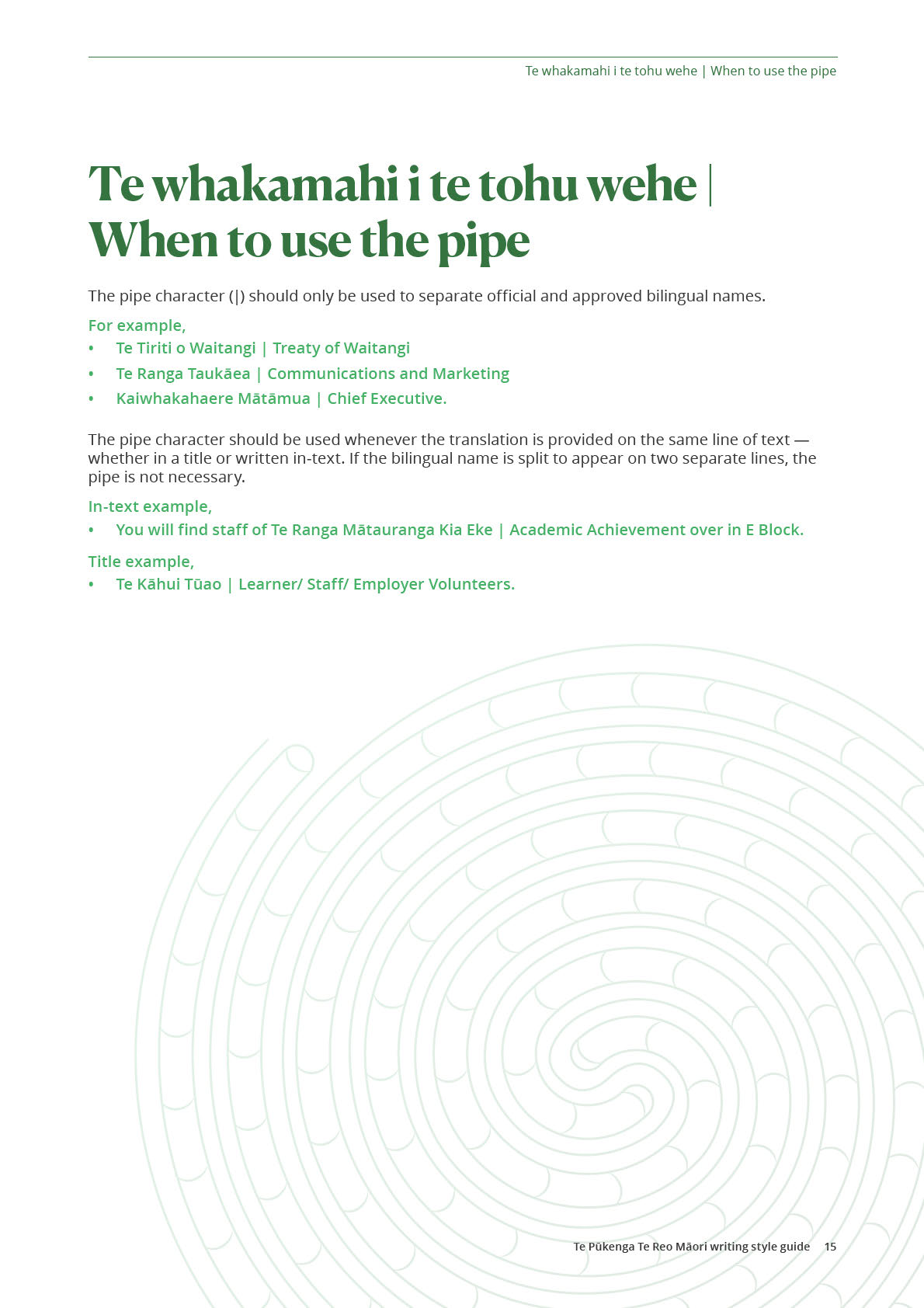
the 1982
Act
under
Released
Information
Official
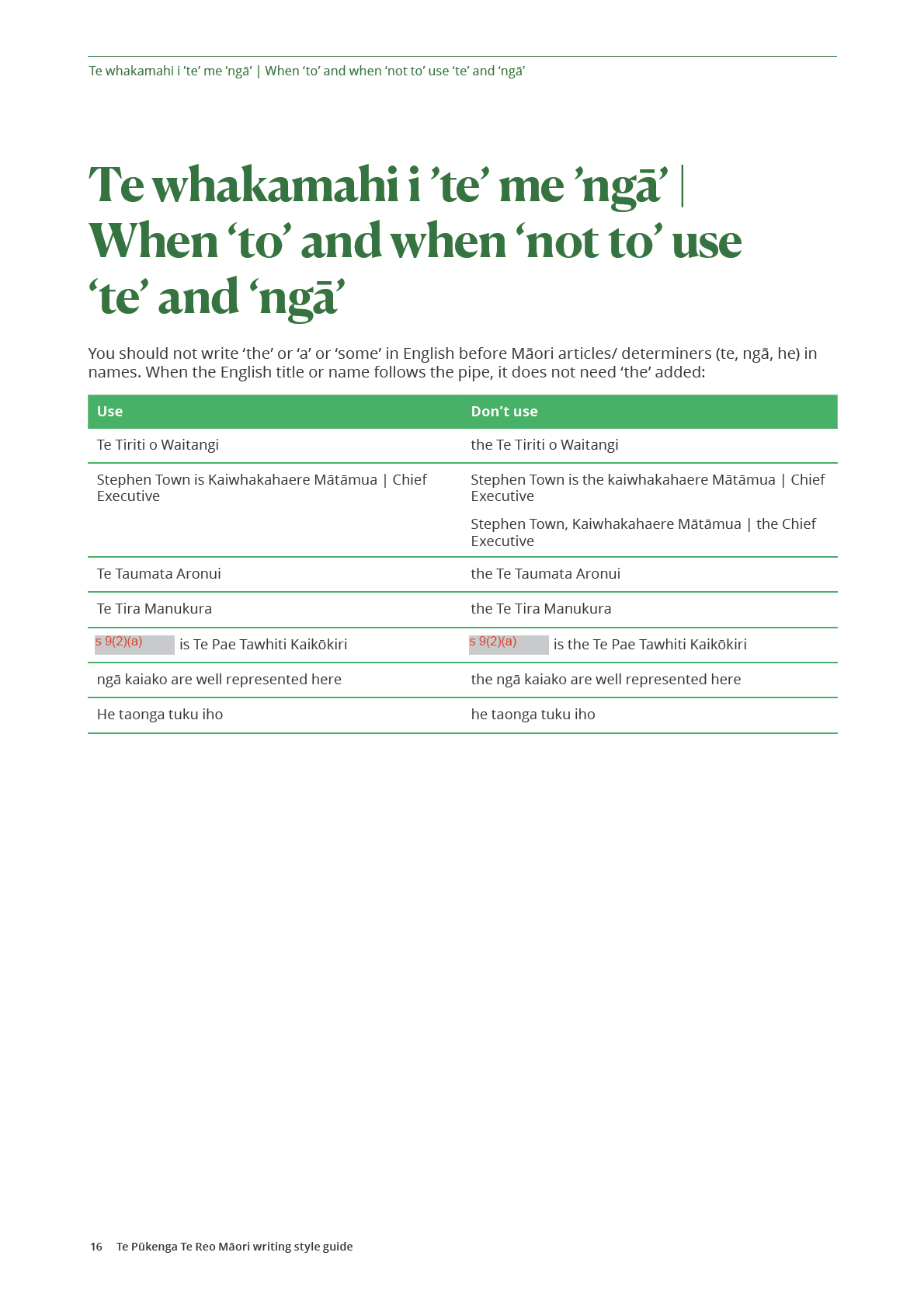
the 1982
Act
under
Released
Information
Official
Ngā Ingoa | Proper names
Ngā Ingoa | Proper names
Capitalisation in proper names
The first letter of the name is capitalised. If there is an initial ‘Te’ the first letter of ‘Te’ is capitalised,
and the first letter of the next word is also capitalised. The only other parts of a name to have initial
capitals are those which are themselves proper names.
For example,
• Te Waipounamu (not Te Wai Pounamu) ‘South Island’
• Te Moana-nui-a-Kiwa ‘Pacific Ocean’
• Te Tauihu-o-Te-Waka-a-Māui ‘Nelson/ Marlborough region’
the 1982
• Taupō-nui-a-Tia ‘Taupō region’
• Te Hiku-o-te-ika-a-Māui ‘Northland region’
• Te Upoko-o-te-ika-a-Māui ‘Wellington region’.
The original Māori names of places embed the stories and history of the people and the land from
Act
a time prior to colonisation. You can find a comprehensive list of Māori place names at Ngā kōrero a
ipurangi o Aotearoa NZ History website:
nzhistory.govt.nz/culture/maori-language-week/1000-maori-place-names
under
Style note
At Te Pūkenga we use both the Māori and English names for local place names, names of
organisations, institutions, Government entities and Te Pūkenga roles, titles and names. These are laid
out beginning with the Māori word first, fol owed immediately by the English place name — with no
intervening punctuation.
We have also considered the practicality of the word order for some readers: putting Māori names/
titles first fol owed by the English works well for readability — the text then moves from Māori name/
title to English name/title, and then the main text flows on in English, so for some readers, this is
smoother in flow than going from English to Māori, and back to English again.
For example,
• Te Whanga-nui-a-Tara Wellington is my home city.
• Thirty students travelled to Turanga Gisborne last week.
Released
Information
• Be sure to visit Maunga Kiekie One Tree Hill when you go to Tāmaki Makaurau Auckland.
• Don’t forget to visit our new Kirikiriroa Hamilton campus next time you’re driving through.
For names beginning with the definite article ‘Te’, this is always written as a separate word.
For example,
• Te Awamutu
• Te Tai-o-Maahunui
• Te Whata-kai-ika-a-Rerekohu
• Te Kei o Tainui
Official
• Te Rauparaha.
It is important to ensure that people have the right to dictate the spel ing of their own name. If in
doubt about the spel ing of name, please do not hesitate to check with the person directly.
Te Pūkenga Te Reo Māori writing style guide 17
Ngā Ingoa | Proper names
Names of iwi, hapū and other kin groups
The col ective title, for example, Ngā / Kā, Ngāi / Kāi, Ngāti / Kāti, Te, Te Āti, Te Aitanga, Te Whānau, is
written separately. The remainder of the name fol ows the rules given earlier in this section.
For example,
• Kāi Tahu / Ngāi Tahu
• Ngāti Whātua
• Kāti Mamoe/ Ngāti Mamoe
• Ngāti Ruanui
• Ngāti Toa
• Ngāti Porou
the
• Ngāti Tama
1982
• Ngā Ruahinerangi
• Te Āti Awa
• Te Rarawa
• Ngāti Raukawa
• Te Aitanga-a-Hauiti
• Te Arawa
• Te Whānau-a-Apanui
• Ngā Puhi.
Act
Names of organisations, institutions, government entities
under
When composing a document and using the name of any organisation particularly ministries,
government departments or major institutions such as iwi enitites and other educational institutes,
please check their websites to ensure you have included their Māori name.
At Te Pūkenga we write the Māori name fol owed by a pipe, fol owed by the English name.
For example,
• Oranga Tamariki | Ministry for Children
• Hīkina Whakatutuki | Ministry of Business, Innovation and Employment
• Hoto Akoranga | StudyLink
• Te Apārangi | Royal Society
• Ngā Pirihimana o Aotearoa | New Zealand Police
• Te Hiranga Tangata | Work and Income New Zealand (WINZ)
Information
• Kāinga Ora | Homes and Communities.
Released
Note: If the names are not in the list of names, please ensure you make contact with the organisation,
iwi, hapū or person to confirm. If you have done so and have had no luck with a response, please file a
request with Te Pūkenga Ohu Reo.
Names that begin with ‘O’
In general, names, and especial y place names, that begin with O, have a macron on the o.
For example,
Official
• Ōtautahi
• Ōwhakatoro
• Ōtehīwai
• Ōtaki
• Ōpōtiki.
18 Te Pūkenga Te Reo Māori writing style guide
Ngā Ingoa | Proper names
Names of the days and months in Te reo Māori
Te Pūkenga givens the option to use either Te Taura Whiri i Te reo Māori (as derived from the
maramataka Māori, Māori lunar calendar) or transliterated (based on English) names for the days of
the week and months of the year. There is no preferance, you are free to chose either option, however
don’t chop and change options within one piece of text.
Days of the week
English
Te Taura Whiri i Te reo Māori
Based on English
the
Monday
Rāhina
Mane
1982
Tuesday
Rātū
Tūrei
Wednesday
Rāapa
Wenerei
Thursday
Rāpare
Tāite
Act
Friday
Rāmere
Paraire
Saturday
Rāhoroi
Hātarei
Sunday
Rātapu
Rātapu
under
Months of the year
English
Te Taura Whiri i Te reo Māori
Based on English
January
Kohitātea
Hānuere
February
Huitanguru
Pēpuere
March
Poutūterangi
Māehe
April
Paengawhāwhā
Āperira
May
Haratua
Mei
June
Pipiri
Hune
Information
July
Hōngongoi
Hūrae
Released
August
Hereturikōkā
Ākuhata
Sepetember
Mahuru
Hepetema
October
Whiringa-ā-nuku
Oketopa
November
Whiringa-ā-rangi
Noema
December
Hakihea
Tīhema
Seasons
Official
English
Māori
Spring
Kōanga
Summer
Raumati
Autumn
Ngahuru
Winter
Takurua/ Hōtoke
Te Pūkenga Te Reo Māori writing style guide 19
Tikanga ā-tuhi mō ā Te Pūkenga tuhinga matua, ingoa, tohu hoki | Te Pūkenga key documents, naming conventions and signage
Tikanga ā-tuhi mō ā Te Pūkenga
tuhinga matua, ingoa, tohu hoki
| Te Pūkenga key documents,
naming conventions and signage
Headers
the 1982
Our vision (Tō mātou tirohanga roa) , values (uara), purpose (pūtake) and priorities (whāinga tōmua)
are foundational to everything we do. They guide the way we operate and are at the fore of every
decision and every interaction. For this reason, Te Pūkenga is committed to fol owing the same rule as
we do for external facing headings, where we begin with Te reo Māori and fol ow on in English.
In support and alignment with our adoption of the orthographic convention that begins with Te reo
Act
Māori, fol owed by the English equivalent, all headings of key Te Pūkenga documents will include
bilingual headers. Headers for key documents (including print and digital col ateral) will begin with the
Māori heading fol owed by the English equivalent. The pipe character should be used whenever the
under
translation is provided on the same line of the header text. If the bilingual header is split to appear on
two separate lines, the pipe is not necessary.
Use
Don’t use
Mahere Haumi | Investment Plan
Investment Plan | Mahere Haumi
Te Pūrongo-ā-Tau | Annual Report
Annual Report / Mahere-ā-Tau
Te Pūrongo-ā-Tāu 2021 | 2021 Annual Report
Mahere-ā-Tau, Annual Report
Copy and script writing
Released
Information
Te Pūkenga will leverage indigenous col ective impact frameworks already developed for the Aotearoa
New Zealand context by seeking to preserve and normalise Te reo Māori. Ensuring Te reo Māori
captures key messages throughout our copy and script writing demonstrates our commitment to
doing this.
Naming and signage
Te Pūkenga is committed to naming conventions and signage where the orthographic convention
begins with Te reo Māori, fol owed by the concept equivalent in English. Please refer to earlier
chapters to understand how this is done.
Official
Note: All naming conventions for Te Pūkenga such as department names, academic programmes of
work, signage etc. will be comissioned via our Te Pūkenga Ohu Reo. Please refer to chapter two of this
guide,
Te Pūkenga Ohu Reo Requests, to find out more.
20 Te Pūkenga Te Reo Māori writing style guide
Tāpiritanga | Appendix
Tāpiritanga | Appendix
Appendix 1 – List of Greetings and sign-offs
Greetings
Formal
Formal Tēnā koe (Name) | Dear (Name) — (Greeting one person)
Tēnā kōrua | Greeting (two people)
Tēnā koutou | Greeting (three or more people)
Ngā mihi o te ahiahi | Good afternoon
the 1982
Piki mai, kake mai ki Te Pūkenga | Welcome to Te Pūkenga
Nau mai, haere mai ki _ | Welcome to _
Informal
Kia ora | Hi, hel o, thank you, to any number of people
Kia ora kōrua | Hel o (two people)
Act
Kia ora koutou | Hel o (three or more people)
Mōrena or Atamārie | Good morningunder
Pōmārie | Good evening
Sign-off
Formal
Nāku, nā | Yours faithfully
Nāku iti noa, nā | Yours sincerely
Ngā mihi | Kind regards or thank you
Ngā mihi nui | Kind regards (with more emphasis on gratitude)
Piki mai, kake mai ki Te Pūkenga | Welcome to Te Pūkenga
Nau mai, haere mai ki _ | Welcome to _
Released
Information
Informal
Nā | From
Hei konā mai | Goodbye for now
Mā te wā | Bye for now, see you later
Noho ora mai | Stay wel , look after yourself, goodbye
Kia pai tō rā | Have a nice day
Kia pai tō kōrua rā | Have a nice day (two people)
Kia pai tō koutou rā | Have a nice day (three or more people)
Official
Kia pai ngā rā whakatā | Have a good weekend
Haere rā | Goodbye (speaker is staying)
E noho rā | Goodbye (speaker is leaving)
Pōmārie | Good evening
Te Pūkenga Te Reo Māori writing style guide 21
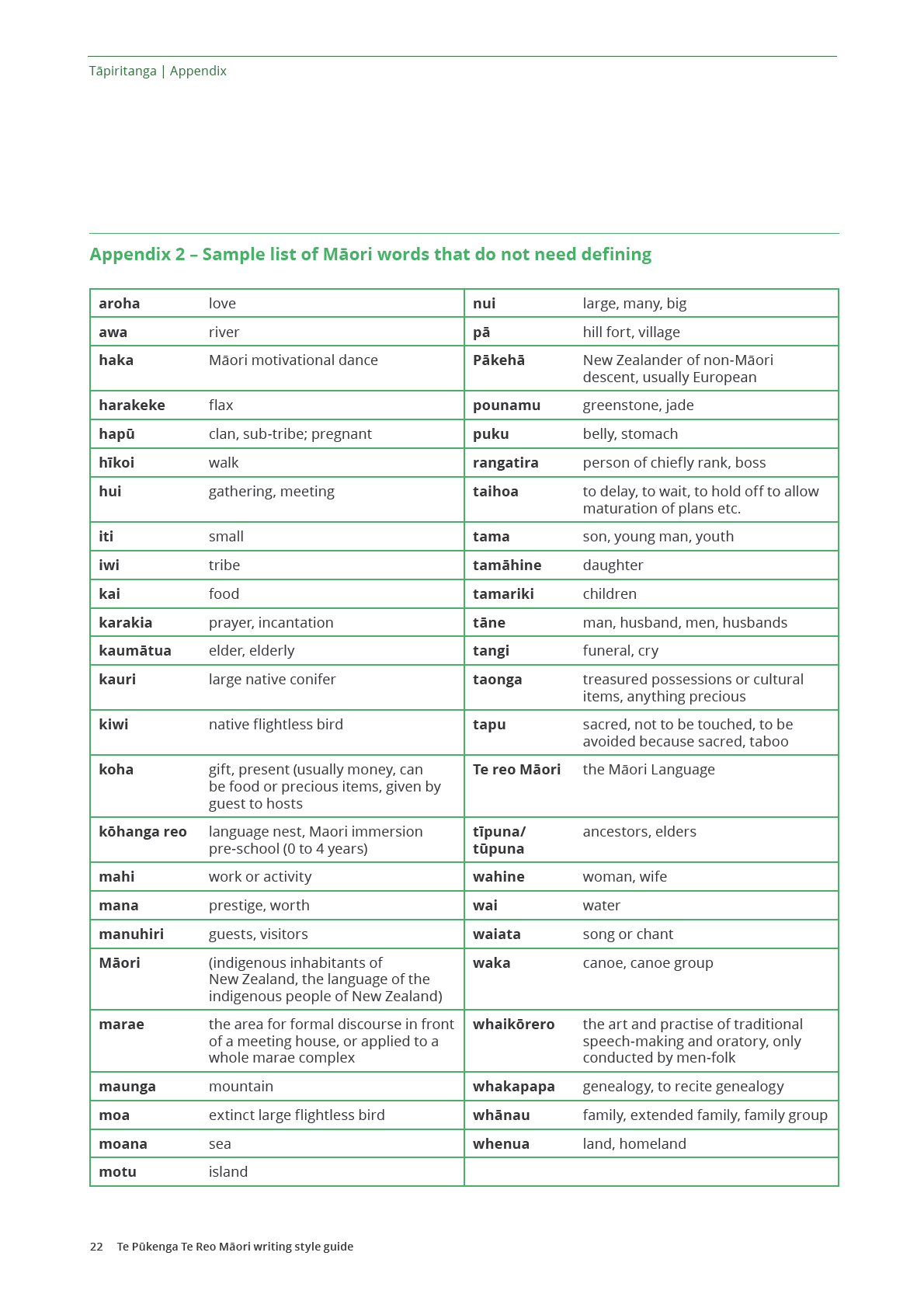
the 1982
Act
under
Released
Information
Official

the 1982
Act
under
Released
Information
Official

the 1982
Act
under
Released
Information
Official










